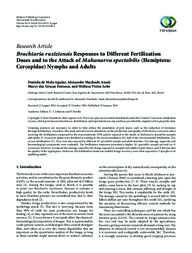Brachiaria ruziziensis Responses to Different Fertilization Doses and to the Attack of Mahanarva spectabilis (Hemiptera: Cercopidae) Nymphs and Adults.
Brachiaria ruziziensis Responses to Different Fertilization Doses and to the Attack of Mahanarva spectabilis (Hemiptera: Cercopidae) Nymphs and Adults.
Author(s): AGUIAR, D. DE M.; AUAD, A. M.; FONSECA, M. DAS G.; LEITE, M. V.
Summary: Cropping practices are necessary in order to help reduce the population of pest insect, such as the induction of resistance through fertilization. Therefore, this study aimed to assess alterations on the production and quality of Brachiaria ruziziensis when receiving the fertilization composed by the macronutrients NPK and/or exposed to the attack of Mahanarva spectabilis nymphs and adults. B. ruziziensis plants were fertilized according to the recommendation (R), half of the recommended fertilization (H), or non-fertilization (C). They were also exposed to different M. spectabilis nymph and adult densities. The damage, regrowth, and bromatological components were evaluated. The fertilization treatment promoted a higher M. spectabilis nymph survival on B. ruziziensis; however, it reduced the damage caused by the forage exposed to nymphs and adults of pest insect, and it did not alter the quality of the signal grass. Moreover, the fertilization treatment enabled forage recovery, even when exposed to 5 nymphs or 10 spittlebug adults.
Publication year: 2014
Types of publication: Journal article
Unit: Embrapa Dairy Cattle
Keywords: Crop fertilization, Pest insect
Observation
Some of Embrapa's publications are published as ePub files. To read them, use or download one of the following free software options to your computer or mobile device. Android: Google Play Books; IOS: iBooks; Windows and Linux: Calibre.
Access other publications
Access the Agricultural Research Database (BDPA) to consult Embrapa's full library collection and records.
Visit Embrapa Bookstore to purchase books and other publications sold by Embrapa.

